Big Bowl Nutrition emphasizes balanced meals in a single dish, combining colorful vegetables, proteins, healthy grains, and flavorful toppings. This approach promotes portion control, variety, and sustainable eating habits, ensuring a satisfying and nutritious experience for all.
Understanding the Concept of a Big Bowl Meal
A Big Bowl Meal is a nutritious, visually appealing dish that combines a variety of ingredients in one bowl. It typically features a base of whole grains or vegetables, topped with proteins like lean meats, legumes, or eggs, and finished with colorful vegetables, healthy fats, and flavorful additions. This concept encourages portion control, customization, and sustainability by reducing food waste. The idea is to create a balanced meal that satisfies hunger while providing essential nutrients. It’s also a flexible approach, allowing individuals to adapt ingredients based on dietary needs, preferences, and what’s available. This method promotes mindful eating and can be prepared in advance for convenience, making it a practical choice for busy lifestyles. By focusing on diversity and freshness, Big Bowl Meals offer a delicious way to prioritize health and enjoy mealtimes.
Importance of Balanced Nutrition in Bowl Meals
Balanced nutrition is the cornerstone of Big Bowl Meals, ensuring each dish provides a wide range of essential nutrients. By combining whole grains, proteins, vegetables, and healthy fats, bowl meals offer a complete nutritional profile. This approach supports energy levels, promotes satiety, and helps maintain overall health. A balanced bowl meal reduces the risk of nutrient deficiencies and supports immune function, digestion, and mental clarity. Incorporating variety ensures exposure to a broad spectrum of vitamins, minerals, and antioxidants. Additionally, balanced nutrition fosters healthier eating habits, encouraging mindful portion control and reducing reliance on processed foods. It’s a sustainable way to nourish the body while enjoying delicious and satisfying meals tailored to individual needs.
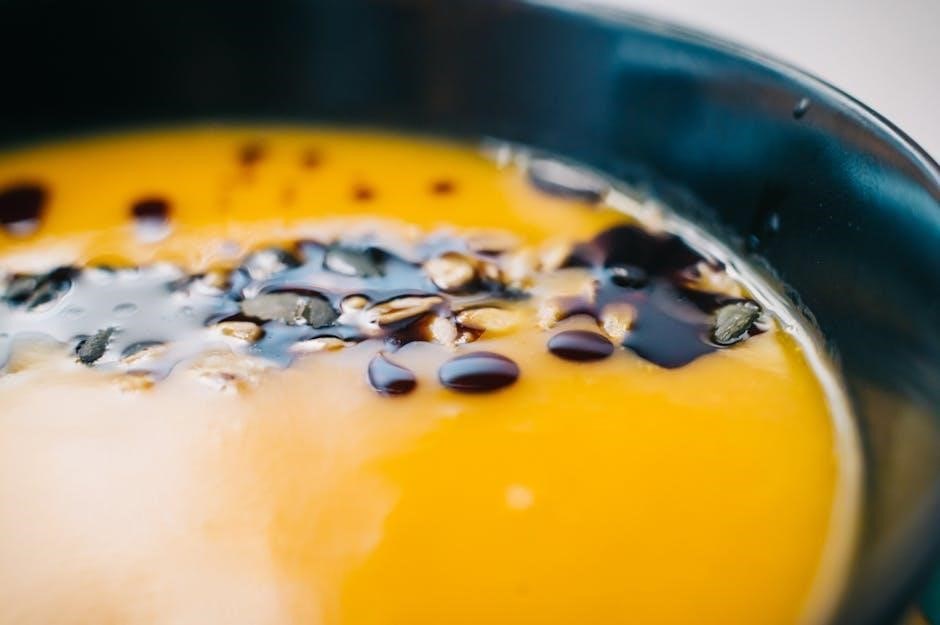
Nutritional Benefits of Big Bowl Meals
Big Bowl Meals offer a nutrient-dense eating experience, combining high-fiber ingredients, lean proteins, vitamins, and minerals to support overall health, digestion, immunity, and sustained energy levels naturally.
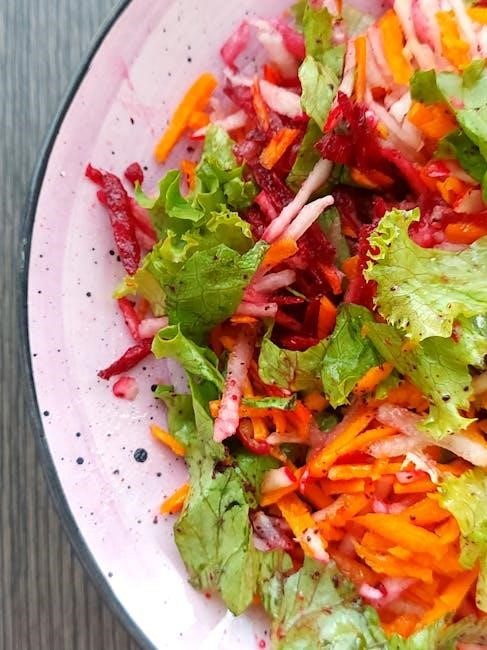
Key Nutrients Found in Bowl Ingredients
Big Bowl meals are packed with essential nutrients, including fiber, vitamins, and minerals from colorful vegetables, whole grains, and lean proteins. Healthy fats like avocado and nuts provide omega-3 fatty acids and vitamin E, while herbs and spices add antioxidants. Grains such as quinoa and brown rice supply B vitamins and minerals like iron and magnesium. Proteins from sources like chicken, tofu, or legumes offer amino acids for muscle repair. Vegetables contribute vitamin A, C, and K, along with anti-inflammatory properties. Together, these ingredients create a balanced mix that supports energy, immunity, and overall well-being, making bowls a nutritious and satisfying meal option.
How Bowl Meals Support Overall Health
Big Bowl meals provide a holistic approach to nutrition, offering a variety of benefits that support overall health. The combination of colorful vegetables, lean proteins, and whole grains ensures a broad spectrum of nutrients, promoting energy and vitality; These meals are rich in antioxidants, which help combat oxidative stress and reduce the risk of chronic diseases. The balance of fiber, proteins, and healthy fats supports healthy blood sugar levels and digestion. Regular consumption of bowl meals can enhance immune function, improve heart health, and even support mental well-being by providing essential nutrients for brain function. This diverse and balanced approach makes bowl meals a great way to maintain long-term health and wellness.

Role of Fiber, Proteins, and Healthy Fats in Bowls
Fiber, proteins, and healthy fats are essential components of a nutritious big bowl meal, each playing a unique role in supporting overall health. Fiber promotes digestive health by preventing constipation and supporting gut microbiota, while also aiding in blood sugar regulation. Proteins are vital for muscle repair, growth, and maintaining energy levels, making them a crucial element for active individuals. Healthy fats, such as those from avocados and nuts, support heart health by lowering cholesterol levels and aiding in the absorption of fat-soluble vitamins. Together, these nutrients create a balanced meal that keeps you full, energized, and supports long-term health goals.
Key Ingredients for a Nutritious Big Bowl
A nutritious big bowl combines fresh vegetables, whole grains, lean proteins, and healthy fats, ensuring a balanced mix of flavors, textures, and essential nutrients for optimal health.
The Best Base Ingredients for Bowl Meals
The foundation of a nutritious big bowl starts with the base ingredients, which provide structure, texture, and essential nutrients. Whole grains like brown rice, quinoa, and oats are excellent choices, offering fiber, vitamins, and minerals. Roasted or sautéed vegetables such as kale, spinach, and sweet potatoes add natural sweetness and a burst of antioxidants. Cauliflower rice is a low-carb alternative, while lentils or chickpeas offer plant-based protein. Even zucchini noodles or soba noodles can serve as a light and versatile base. These ingredients create a flavorful and nutritious starting point, ensuring your bowl is both satisfying and balanced. Experimenting with different bases allows for variety and caters to various dietary preferences and needs.
Top Protein Sources to Include
Incorporating high-quality protein into your big bowl is essential for satiety and muscle repair. Grilled chicken, turkey, or tofu are excellent lean options, while salmon provides omega-3 fatty acids for heart health. Beans like black beans, chickpeas, and lentils are versatile plant-based proteins packed with fiber. Eggs, whether boiled or fried, add a creamy texture and protein boost. For vegetarians, tempeh or edamame are great alternatives. Nuts and seeds, such as almonds, chia seeds, or hemp seeds, offer a crunchy protein topping; Including a variety of these sources ensures your bowl is both nutritious and satisfying, catering to diverse dietary needs.
Vegetables: Colorful and Nutrient-Rich Additions
Vibrant vegetables are a cornerstone of a nutritious big bowl, offering a rainbow of colors and essential nutrients. Leafy greens like spinach, kale, and arugula provide iron and vitamins, while broccoli, Brussels sprouts, and cauliflower deliver cancer-fighting compounds. Bell peppers, carrots, and sweet potatoes add vitamin A and C, promoting healthy vision and immunity. Roasted or grilled vegetables like zucchini, eggplant, and asparagus enhance flavor and texture. Including a variety ensures a broad spectrum of vitamins, minerals, and antioxidants. Fresh or sautéed, vegetables bring balance and freshness to your bowl, making it both visually appealing and nutritionally robust. They also support digestion and overall well-being, making them a must-have in every big bowl creation.
Whole Grains and Their Benefits
Whole grains are a vital component of a nutritious big bowl, offering a wealth of health benefits. They include grains like quinoa, brown rice, farro, and bulgur, which are rich in fiber, vitamins, and minerals. Whole grains provide sustained energy due to their complex carbohydrates and help regulate blood sugar levels. They also support heart health by lowering cholesterol and reducing inflammation. Incorporating whole grains into your bowl adds texture and variety while promoting digestive health. Their nutrient-dense profile makes them an excellent base for balanced meals, ensuring you receive essential nutrients like iron, selenium, and B vitamins. Choosing whole grains over refined options is a simple way to enhance the nutritional value of your big bowl, supporting overall well-being and long-term health goals. They are versatile, flavorful, and a cornerstone of a healthy diet.
Toppings That Enhance Flavor and Nutrition
Toppings are the final touches that elevate a big bowl meal, adding both flavor and nutritional value. Fresh herbs like cilantro, basil, or parsley introduce vibrant flavors and antioxidants. Nuts and seeds, such as almonds, chia seeds, or pumpkin seeds, provide healthy fats, protein, and crunch. Avocado slices contribute creamy texture and heart-healthy monounsaturated fats. Fermented foods like kimchi or pickled vegetables enhance digestion and immunity. A drizzle of tahini or a sprinkle of nutritional yeast can add richness and plant-based nutrients. These toppings not only diversify the taste but also balance the meal, ensuring it’s satisfying and nutrient-dense. By thoughtfully selecting toppings, you can customize your bowl to meet your dietary preferences and boost its overall appeal. They transform a simple meal into a delicious, wholesome experience, making every bite enjoyable and beneficial.
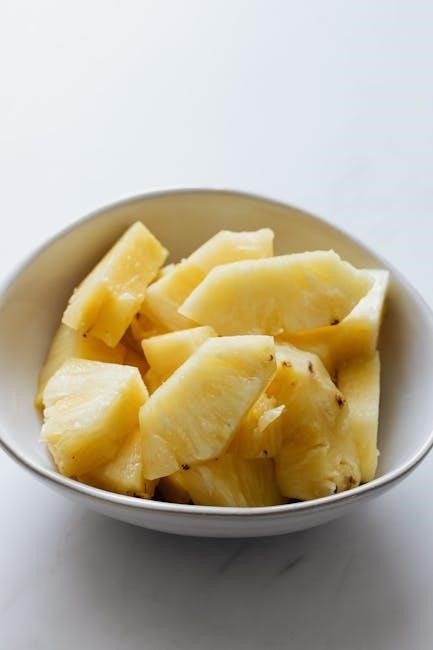
Health Benefits of Eating Big Bowl Meals
Big bowl meals promote overall wellness by offering balanced nutrition. They provide essential nutrients, supporting energy levels, immunity, and mental clarity. The variety of ingredients ensures a holistic approach to health, making them a sustainable and satisfying dietary choice.
Weight Management Through Portion Control
Big bowl meals can aid in weight management by emphasizing portion control and balanced ingredient ratios. A structured bowl with a base, protein, vegetables, and toppings ensures satiety without overeating. The combination of fiber-rich vegetables, lean proteins, and whole grains helps regulate calorie intake. By measuring portions, individuals can maintain a healthy metabolism and energy levels. The variety of nutrients also reduces cravings, promoting a steady weight loss journey. Mindful eating encouraged by bowl meals further supports sustainable weight management, making them a practical choice for those seeking a balanced lifestyle.
Improved Digestion with High Fiber Content
Big bowl meals are rich in fiber, which plays a crucial role in improving digestion. High-fiber ingredients like whole grains, vegetables, and legumes promote regular bowel movements and prevent constipation. Fiber also helps maintain a healthy gut microbiome by acting as a prebiotic, supporting the growth of beneficial bacteria. This can enhance nutrient absorption and reduce symptoms of irritable bowel syndrome (IBS). Additionally, fiber adds bulk to meals, slowing down digestion and preventing rapid spikes in blood sugar. By incorporating a variety of colorful vegetables, whole grains, and plant-based proteins, big bowl meals provide sustained digestive health benefits, ensuring a balanced and functioning digestive system.
Boosting Immunity with Nutrient-Dense Foods

Big bowl meals are packed with nutrient-dense ingredients that play a vital role in boosting immunity. Leafy greens, berries, and vibrant vegetables are rich in vitamins A and C, which support immune function. Sweet potatoes provide beta-carotene, a precursor to vitamin A, essential for fighting infections. Cruciferous vegetables like broccoli contain sulforaphane, which has antimicrobial properties. Herbs and spices, such as garlic and turmeric, add antimicrobial benefits. Whole grains and legumes offer zinc and iron, crucial for immune cell production. The combination of these foods creates a powerful immune-boosting effect, helping the body fend off pathogens and maintain overall health. A balanced big bowl meal ensures a robust immune system, ready to combat illness and support long-term wellness.
Mental Health Benefits of Balanced Meals
A well-balanced big bowl meal offers significant mental health benefits by providing essential nutrients that support brain function and emotional well-being. Foods rich in omega-3 fatty acids, such as fatty fish or flaxseeds, promote brain health and may reduce symptoms of depression and anxiety. Antioxidants from colorful vegetables and fruits combat oxidative stress, which is linked to mental health disorders. Whole grains and complex carbohydrates help stabilize blood sugar levels, preventing mood swings. Additionally, the act of creating and enjoying a nutritious meal can foster a sense of accomplishment and satisfaction, reducing stress and promoting mindfulness. A balanced diet contributes to better mental clarity, emotional resilience, and overall psychological well-being, making big bowl meals a holistic approach to health.
Practical Tips for Building a Balanced Big Bowl
Start with a nutritious base, add protein, colorful vegetables, and healthy fats for a balanced meal that’s both satisfying and packed with nutrients. Incorporate variety and texture for maximum nutrition and flavor.
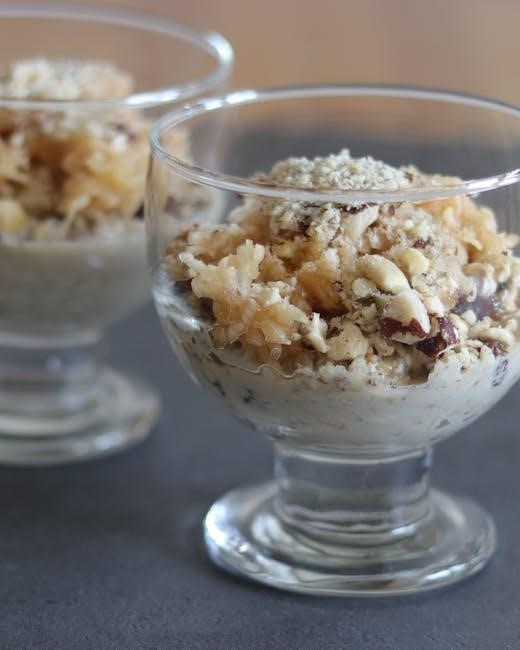
Understanding Portion Sizes and Serving Guidelines
Portion control is essential for maintaining a balanced diet, even in big bowl meals. Start by measuring ingredients to gauge serving sizes accurately. A general guideline is to allocate 50% of the bowl to vegetables, 30% to protein, and 20% to whole grains. Use a food scale or measuring cups to avoid overestimating portions. Pay attention to calorie-dense toppings like nuts, seeds, and dressings, as they can quickly add up. Adjust portions based on individual caloric needs or activity levels. For example, active individuals may require larger protein servings, while those managing weight might opt for smaller grain portions. Understanding these guidelines helps create meals that are both nourishing and satisfying, promoting healthier eating habits without deprivation.
Meal Prepping for Quick and Nutritious Bowls
Meal prepping is a fantastic way to ensure quick and nutritious big bowl meals throughout the week. Start by planning your meals in advance and creating a grocery list of fresh, seasonal ingredients. Chop and store vegetables like leafy greens, bell peppers, and carrots in airtight containers. Cook proteins such as grilled chicken, beans, or tofu in bulk and portion them out. Whole grains like quinoa or brown rice can also be pre-cooked and refrigerated. Assemble individual bowl components in separate containers to mix and match during the week. This method saves time, reduces food waste, and ensures that healthy, balanced meals are always within reach. Consistency in meal prepping is key to maintaining a nutritious and enjoyable diet.
How to Read Nutrition Labels for Healthy Choices
Reading nutrition labels is crucial for making informed decisions when building a nutritious big bowl. Start by checking the serving size and calorie count to ensure portions align with your needs. Focus on macronutrients like fiber, protein, and healthy fats, which are essential for sustained energy and satiety. Look for whole grains, lean proteins, and minimal added sugars or sodium. Examine the ingredient list to avoid artificial additives and prioritize whole foods. Pay attention to the Percent Daily Values (DV) to assess nutrient contributions. By understanding these components, you can select ingredients that support a balanced diet and enhance the nutritional quality of your big bowl meals.
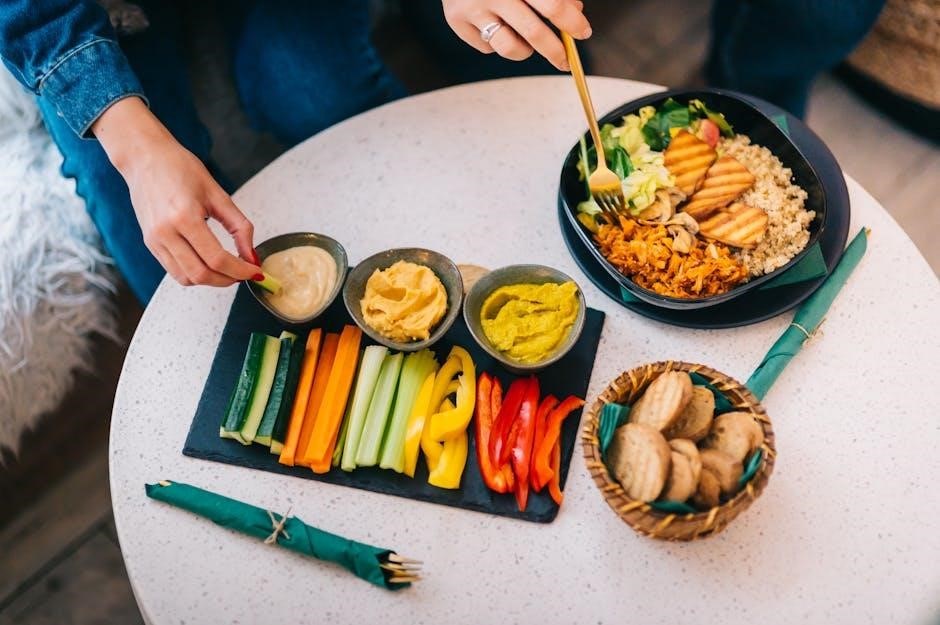
Family-Friendly Big Bowl Recipes
Delicious and nutritious bowls featuring colorful vegetables, lean proteins, and whole grains, designed to please both kids and adults while catering to various dietary preferences.
Healthy Bowl Ideas for Children
Creating nutritious and appealing bowls for kids is easy with colorful, kid-friendly ingredients. Start with a base like quinoa or brown rice, then add vibrant veggies such as cherry tomatoes, carrots, and edamame. Incorporate lean proteins like grilled chicken, beans, or tofu for energy. Top with fun elements like avocado slices, hummus, or a drizzle of yogurt-based sauce to make it tasty. Let kids customize their bowls to encourage excitement about mealtime. Packing bowls with a variety of textures and flavors ensures they’re both nourishing and engaging. This approach helps kids develop healthy eating habits while enjoying balanced, satisfying meals.
Customizable Bowls for Different Dietary Needs
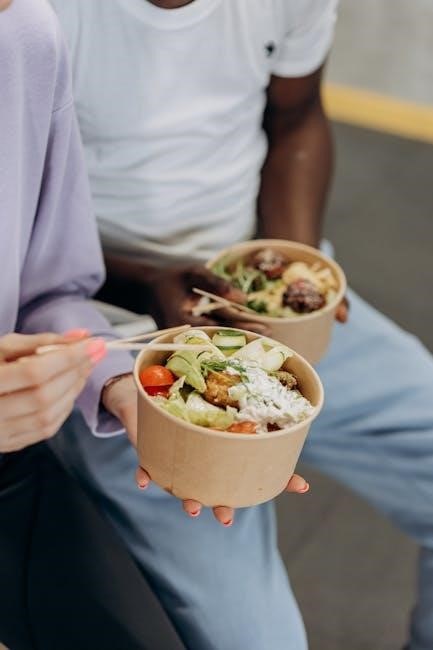
Customizable bowls are ideal for accommodating diverse dietary needs, ensuring balanced and enjoyable meals for everyone. Vegetarians can opt for quinoa or brown rice with tofu or chickpeas as protein sources. Gluten-free options might use cauliflower rice or zucchini noodles as bases. For keto diets, consider roasted vegetables and avocado as the main components. Adding fresh vegetables, nuts, and seeds provides essential nutrients and texture. The adaptability of bowls makes them perfect for family gatherings or social events, catering to various preferences without compromising on flavor or nutrition. This ensures inclusivity and satisfaction for all diners.
Engaging the Whole Family in Meal Preparation
Engaging the whole family in meal preparation fosters a sense of collaboration and fun, making big bowl nutrition a shared experience. Assigning age-appropriate tasks, such as washing vegetables or mixing toppings, helps children feel involved. Teens can assist with meal planning, teaching them about portion control and nutrition. This interaction not only strengthens family bonds but also encourages healthier eating habits. Teaching kids to prepare meals empowers them with essential life skills. Involving everyone ensures that each family member feels valued and excited about the meal. It also allows for personalized preferences, making mealtime enjoyable for all. This collective effort promotes a positive relationship with food and supports overall well-being.
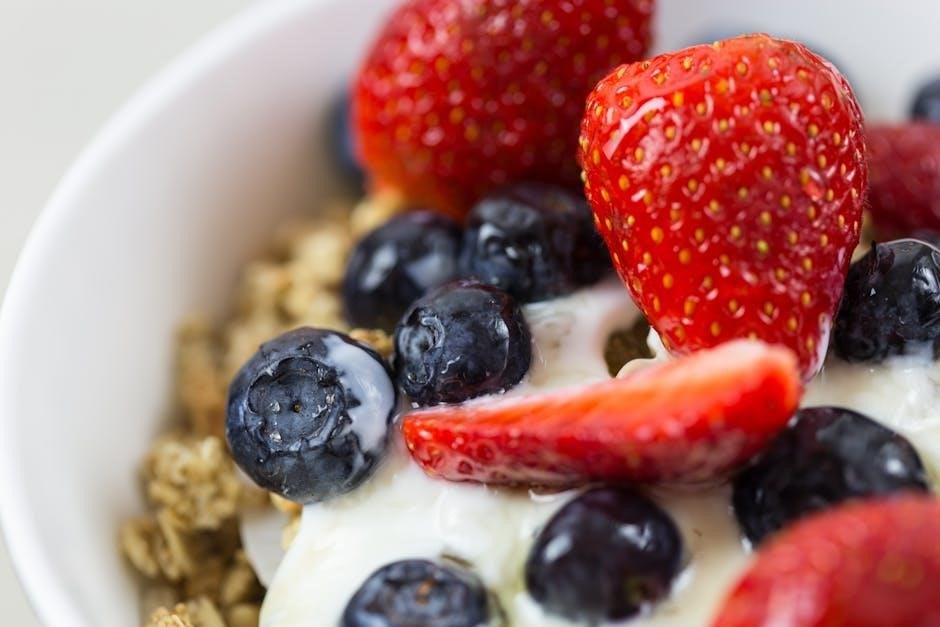
Budget-Friendly and Sustainable Eating
Budget-friendly and sustainable eating involves smart shopping, meal planning, and reducing food waste. Buying in bulk, using seasonal produce, and repurposing leftovers help save money and minimize environmental impact.
affordable Ingredients for Big Bowl Meals
Affordable Ingredients for Big Bowl Meals
Creating a nutritious big bowl meal doesn’t have to break the bank. Start with affordable base ingredients like brown rice, quinoa, or oats, which are rich in fiber and versatile. Canned beans, chickpeas, and corn are budget-friendly protein and nutrient-rich additions. Frozen vegetables like broccoli, peas, and spinach retain their nutrients and cost less than fresh options. Eggs, tofu, and lentils are inexpensive protein sources that pack a punch. Incorporate affordable spices and herbs for flavor without added expense. Shopping for seasonal produce and buying in bulk can also reduce costs. These ingredients allow you to build a balanced meal that’s both nourishing and economical, making healthy eating accessible to everyone.
Reducing Food Waste Through Bowl Recipes
Big bowl meals are an excellent way to reduce food waste by utilizing leftover ingredients. Start by using leftover grains, roasted vegetables, or proteins as the base of your bowl. Flexible recipes encourage creativity, allowing you to incorporate odds and ends from your fridge or pantry. For example, wilted greens, scraps of cheese, or leftover cooked meats can add flavor and texture. Smart shopping and meal planning also help minimize waste by ensuring ingredients are used before expiration. Seasonal produce, often purchased in bulk, can be repurposed in multiple bowls throughout the week. This approach not only saves money but also supports sustainable eating by giving leftover food a new purpose.
Sustainable Shopping Tips for Bowl Ingredients
Adopting sustainable shopping practices is key to creating eco-friendly big bowl meals. Prioritize locally sourced and seasonal ingredients, as they reduce carbon footprints from transportation. Opt for bulk purchases of grains, beans, and nuts to minimize packaging waste. Choose whole, unprocessed foods, such as brown rice or quinoa, which are often more sustainable than refined alternatives. Select produce with minimal packaging or buy items like avocados and bananas in reusable containers. Avoid single-use plastics by shopping with cloth bags or glass containers. Support eco-conscious brands that prioritize sustainable farming and fair trade practices. By making these choices, you contribute to a healthier planet while stocking your pantry with nutritious bowl ingredients.
Special Dietary Needs and Big Bowl Meals
Big bowl meals offer flexibility for various dietary needs, providing a variety of ingredients that support balanced nutrition and accommodate preferences like vegan, gluten-free, or keto diets.
Vegan and Vegetarian Bowl Options
Vegan and vegetarian bowl options are a great way to enjoy nutrient-rich meals while adhering to plant-based diets. These bowls often feature hearty ingredients like beans, lentils, tofu, and tempeh as protein sources, paired with whole grains such as quinoa, brown rice, or farro. Colorful vegetables like roasted sweet potatoes, broccoli, and kale add fiber, vitamins, and minerals. Healthy fats from avocado, nuts, or seeds enhance flavor and provide essential omega-3 fatty acids. Herbs and spices like turmeric, cumin, and tahini can elevate the taste without compromising dietary preferences. These bowls are not only delicious but also support overall health by reducing the risk of chronic diseases. They are versatile, making it easy to customize based on seasonal produce and personal preferences.
Gluten-Free Alternatives for Bowl Ingredients
For those with gluten intolerance or sensitivity, gluten-free alternatives make big bowl meals accessible and enjoyable. Replace traditional grains like wheat and barley with gluten-free options such as quinoa, brown rice, or cauliflower rice. Protein sources like grilled chicken, tofu, or legumes are naturally gluten-free and can be paired with a variety of vegetables. Use gluten-free soy sauce or tamari for seasoning, and opt for corn or rice-based noodles instead of wheat-based ones. Fresh herbs and spices add flavor without introducing gluten. Always check labels to ensure ingredients like sauces and seasonings are gluten-free. These alternatives allow for creative and nutritious bowl meals that cater to dietary restrictions while maintaining great taste and texture.
Low-Carb and Keto-Friendly Bowl Recipes
Low-carb and keto-friendly bowl recipes focus on minimizing carbohydrates while maximizing nutrients and flavor. Start with a base of cauliflower rice, zucchini noodles, or a bed of leafy greens like spinach or kale. Add protein sources such as grilled chicken, salmon, or eggs. Incorporate healthy fats like avocado slices, olive oil, or nuts for sustained energy. Choose vegetables low in carbs, such as broccoli, bell peppers, and mushrooms. Avoid sugary dressings and opt for olive oil, vinegar, or keto-friendly ranch; These bowls are designed to keep you in ketosis while providing balanced nutrition. They support weight loss, improve blood sugar control, and offer stable energy levels, making them a great option for those following a keto lifestyle.